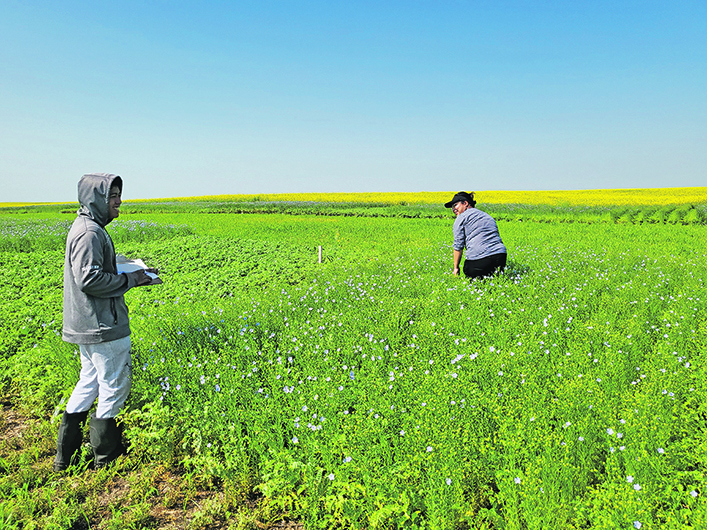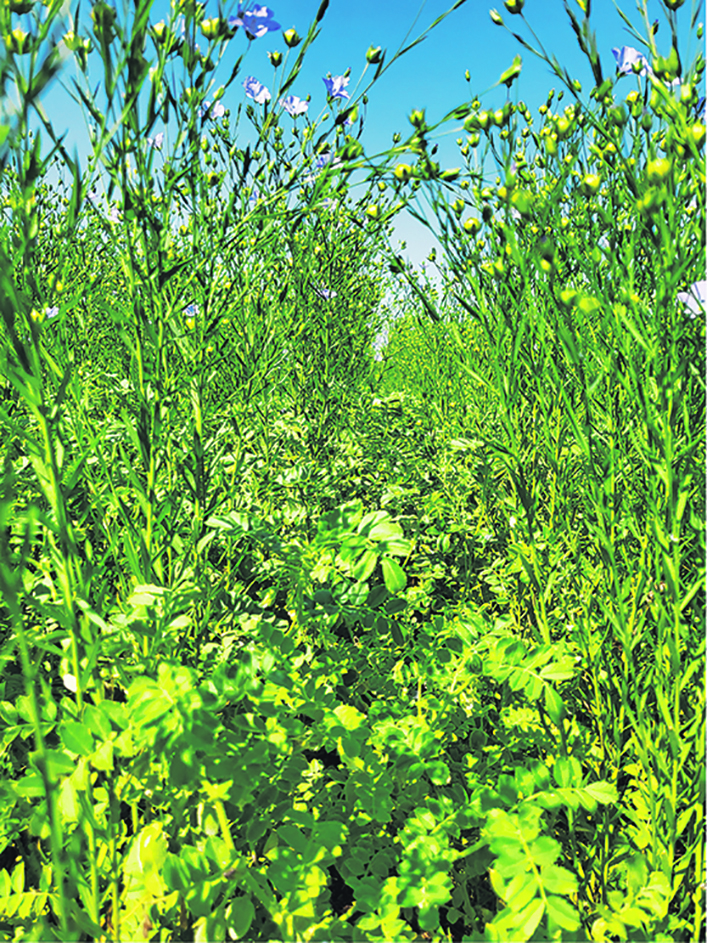Compared to the monocrops, Lana Shaw’s chickpea-flax combo was the clear winner, showing resiliency during extreme growing conditions.
“It really put this chickpea-flax system under a pressure cooker of being seeded late with excess moisture. That’s a bad scene for chickpeas,” said Shaw, research manager at the South East Research Farm in Redvers, Sask.
“We’re growing them in Redvers where it’s really not a very reasonable place to try and grow chickpeas in the first place.”
The facility is part of a network of farmer-directed research organizations. Shaw is wrapping up the third season of a trial that compared chickpea-flax intercrops to monocrops.
Results will also be studied across several Saskatchewan growing areas in Swift Current, Indian Head, Saskatoon and Melfort, each of which had different growing conditions.
In Redvers, the 2022 season started with about 20 inches of precipitation in spring that delayed seeding until June 2.
The monocrops were less mature, had more disease and a low yield. The intercropped flax yielded an additional 10 to 15 bushels an acre and about 50 percent more chickpeas.
“It further reinforces that the intercrops can expand the area of adaptation for a crop like chickpeas by making them more determinant,” Shaw said.
“They mature more consistently and in a more timely way. Indeterminate crops just keep flowering and flowering and flowering until they freeze, which results in terrible quality and a lot of green, terrible quality pulses. Whereas with the intercrops, we were getting more … seeds actually maturing properly and less green, immature, frozen chickpeas in there.
“So, the yield alone, we haven’t done the analysis yet on the quality of it, but I’m expecting there to be dramatic differences, improvements in the quality due to intercropping. That there’s fewer green seeds, less diseased seed and that should result in a more viable crop,” she said.
This has been Tyler Wilson’s experience on his farm at Admiral, Sask. This is the fourth year he has grown the chickpeaflax intercrop on 250 acres. He has grown other intercrop combos for the better part of a decade.
“We’ve done chickpea-flax side by side with monocrop chickpeas and we’ve never seen a yield loss with chickpeas and flax versus monocrop chickpeas. If you don’t see a yield gain, it will cost you because of the cost of separation,” he said.
In 2020, the flax in the chickpea-flax crop was worth considerably more than if he had grown only one crop in the field, Wilson recalled.
“We actually made more money because of the flax being worth more than the chickpeas than if we had grown a monocrop.”
Shaw considered several input and preparation factors for the Redvers study.
“We either went with zero nitrogen or 60 kilograms per hectare of nitrogen. In this trial we didn’t put down any phosphate because we didn’t really have room in the drill. So, we’re going onto land that has traditionally been well-fertilized with phosphate and getting away without it for one year,” she said.
One fungicide application was applied in the first week of August.
“We’re trying to hit a happy medium where we want some disease pressure but we don’t want it to wipe out the whole trial because we want to see differences in the disease responses,” she said.
All test sites were no-till and seeded on June 2.
Sulfentrazone (Authority) was the main broadleaf herbicide, plus a grass herbicide.
“We’re using the chemicals that are available and looked really good this year other than there was excessive moisture,” Shaw said.
Wilson has also compared outcomes using fungicide on his monocrops to chickpea-flax with no fungicide and saw no yield gains with fungicide.
In Saskatchewan, monoculture chickpea production is restricted to a relatively small area, using about 100,000 acres and reliant on repeated fungicide applications.
The relatively new high-risk crop is prone to quality issues because of excess moisture, frost and disease problems.
“What we’re aiming this for is a means of reducing, not really eliminating the need for fungicide. So, it’s an additional tool in the toolbox to make the chickpeas a more resilient, dependable crop and expand the area where it’s possible to grow chickpeas,” Shaw said.
“Chickpea-flax might have a nice fit in areas where currently people usually grow lentils. With the root rot problems that the lentils are currently having, having an alternative pulse to switch to in lentil country could be very important.
“That’s one of the hypotheses behind this trial is that we can take chickpeas out of that small chickpea production area into a larger region and have them be adopted if they’re intercropped.”
Shaw said research will hopefully reveal the optimal balance between chickpeas and flax.
Growers remain leery about intercropping, she added, particularly when it comes to combine settings and separation of the two crops.
“The chickpeas thresh the flax whole as they’re going through the combine. So basically, you set the combine for the chickpeas and turn down the fan speed just enough that you don’t blow the flax out the back of the combine.
“There are farmers doing this on thousands of acres and have been for over 10 years. So, it does work for mechanization. It’s not a literal obstacle, it’s more of a mental obstacle – people being able to gain some confidence that they’re going to be able to actually harvest that with a regular combine,” she said.
After harvest, the two grains are easily separated because of their size variation.
Wilson used to contract the separation but with the addition of a rotary screen the cleaning is done at his farm.

However, the do-it-yourself process comes with added costs of time and money.
“I would say separating the chickpeas would be the equivalent (in cost) to two passes of fungicide on those (250) acres. Two passes of fungicide are equal to one separation of the crop on your own, so about half a day in time.
“It depends on how many acres you’re growing … and how much flax is in it versus chickpeas, so the less flax the quicker you can complete. Usually, we put a rough cost of about 50 cents a bushel, with the setting up and moving the product around,” he said.
Growing an intercrop for conventional production could be a good fit, said Shaw.

“If you’re having trouble with your lentils right now, then substitute out the chickpea-flax and put it in sequence with your other monocrops. It’s ideally after a cereal, not great after a canola because of volunteers. You have no means of controlling volunteer canola. Its possible to clean volunteer canola out of flax but it’s not really easy or cheap.
Wilson consistently grows canola, corn, durum, large green lentils, yellow mustard, flax and field peas. He will also grow chickpea-flax in between two cereal crop years.
“It’s a way to insert some real diversity into the grain crop, annual crop rotation. Growing two grain crops at a time, that’s a lot of crop diversity and that’s something that we’re trying to achieve more of now. I like that,” Shaw said.


















